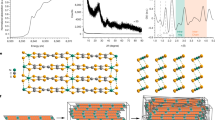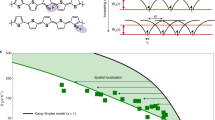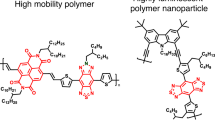Abstract
Despite nearly three decades of materials development, the transport properties in the ‘metallic state’ of the so-called conducting polymers are still not typical of conventional metals1,2,3,4,5,6,7. The hallmark of metallic resistivity—a monotonic decrease in resistivity with temperature—has not been obtained at temperatures over the full range below room temperature; and a frequency dependent conductivity, σ(ω), typical of metals has also not been observed. In contrast, the low-temperature behaviour of ‘metallic’ polymers has, in all previous cases, exhibited an increase in resistivity as temperature is further decreased, as a result of disorder-induced localization of the charge carriers1,2,3,4. This disorder-induced localization also changes the infrared response such that σ(ω) deviates from the prediction of Drude theory5,6,7. Here we report classic metallic transport data obtained from truly metallic polymers. With polyaniline samples prepared using self-stabilized dispersion polymerization8, we find that for samples having room-temperature conductivities in excess of 1,000 S cm-1, the resistivity decreases monotonically as the temperature is lowered down to 5 K, and that the infrared spectra are characteristic of the conventional Drude model even at the lowest frequencies measured.
This is a preview of subscription content, access via your institution
Access options
Subscribe to this journal
Receive 51 print issues and online access
$199.00 per year
only $3.90 per issue
Buy this article
- Purchase on Springer Link
- Instant access to full article PDF
Prices may be subject to local taxes which are calculated during checkout




Similar content being viewed by others
References
Heeger, A. J. Nobel Lecture: Semiconducting and metallic polymers: The fourth generation of polymeric materials. Rev. Mod. Phys. 73, 681–700 (2001)
Menon, R., Yoon, C. O., Moses, D. & Heeger, A. J. in Handbook of Conducting Polymers 2nd edn (eds Skotheim, T. A., Elsenbaumer, R. L. & Reynolds, J. R.) 27–84 (Marcel Dekker, New York, 1998)
Heeger, A. J. The critical regime of the metal-insulator transition in conducting polymers: experimental studies. Phys. Scr. T102, 30–35 (2002)
Kaiser, A. B. Systematic conductivity behaviour in conducting polymers: effects of heterogeneous disorder. Adv. Mater. 13, 927–941 (2001)
Kiebooms, R., Menon, R. & Lee, K. in Handbook of Advanced Electronic and Photonic Materials and Devices Vol. 8 (ed. Nalwa, H. S.) 1–102 (Academic, San Diego, 2001)
Kohlman, R. S., Joo, J. & Epstein, A. J. in Physical Properties of Polymers Handbook (ed. Mark, J. E.) 453–478 (AIP, New York, 1996)
Lee, K. in Encyclopedia of Nanoscience and Nanotechnology Vol. 5 (ed. Nalwa, H. S.) 537–549 (American Scientific Publishers, San Diego, 2004)
Lee, S.-H., Lee, D.-H., Lee, K. & Lee, C.-W. High-performance polyaniline prepared via polymerization in a self-stabilized dispersion. Adv. Funct. Mater. 15, 1495–1500 (2005)
Ashcroft, N. W. & Mermin, N. D. Solid State Physics (Saunders College, New York, 1976)
Landau, L. D. The theory of a Fermi liquid. Sov. Phys. JETP 3, 920–925 (1957)
Pines, I. D. & Nozieres, P. The Theory of Quantum Liquids (Benjamin, Menlo Park, 1966)
Mott, N. F. Metal-insulator Transitions (Taylor & Francis, London, 1990)
Anderson, P. W. The Fermi glass: theory and experiment. Comments Solid State Phys. 2, 193–198 (1970)
Fite, C., Cao, Y. & Heeger, A. J. Magnetic susceptibility of one-dimensional metallic chains in solution. Solid State Commun. 73, 607–609 (1990)
Park, Y. W., Choi, E. S. & Suh, D. S. Metallic temperature dependence of resistivity in perchlorate doped polyacetylene. Synth. Met. 96, 81–86 (1998)
Moses, D., Denenstein, A., Pron, A., Heeger, A. J. & MacDiarmid, A. G. Specific heats of pure and doped polyacetylene. Solid State Commun. 36, 219–224 (1980)
Reghu, M., Cao, Y., Moses, D. & Heeger, A. J. Counterion-induced processibility of polyaniline: transport at the metal-insulator boundary. Phys. Rev. B 47, 1758–1764 (1993)
Yoon, C. O., Reghu, M., Moses, D. & Heeger, A. J. Transport near the metal-insulator transition: polypyrrole doped with PF6 . Phys. Rev. B 49, 10851–10863 (1994)
Wang, Z. H., Scherr, E. M., MacDiarmid, A. G. & Epstein, A. J. Transport and EPR studies of polyaniline: a quasi one-dimensional conductor with three dimensional “metallic” states. Phys. Rev. B 45, 4190–4202 (1992)
Lee, K., Heeger, A. J. & Cao, Y. Reflectance of polyaniline protonated with camphor sulfonic acid: disordered metal on the metal-insulator boundary. Phys. Rev. B 48, 14884–14891 (1993)
Lee, K. et al. Nature of the metallic state in conducting polypyrrole. Adv. Mater. 10, 456–459 (1998)
Kohlman, R. S. et al. Limit for metallic conductivity in conducting polymers. Phys. Rev. Lett. 78, 3915–3918 (1995)
Chapman, B. et al. Low-energy conductivity of PF6-doped polypyrrole. Phys. Rev. B 60, 13479–13483 (1999)
Tzamalis, G., Zaidi, N. A., Homes, C. C. & Monkman, A. P. Doping-dependent studies of the Anderson-Mott localization in polyaniline at the metal-insulator boundary. Phys. Rev. B 66, 085202 (2002)
Lee, K. & Heeger, A. J. Optical investigation of intra and interchain charge dynamics in conducting polymers. Synth. Met. 128, 279–282 (2002)
MacDiarmid, A. G. & Epstein, A. J. Secondary doping in polyaniline. Synth. Met. 69, 85–92 (1995)
Yan, H., Ohta, T. & Toshima, N. Stretched polyaniline films doped by (± )-10-camphorsulfonic acid: anisotropy and improvement of thermoelectric properties. Macromol. Mater. Eng. 286, 139–142 (2001)
Acknowledgements
We thank K. Bechgaard for discussions. K.L. was supported at PNU by the National Program for Nanoscience and Technology of the Korea Science and Engineering Foundation. S.-H.L. acknowledges financial support at AU from the Korea Science and Engineering Foundation through the Hyper Structured Organic Materials Research Center in Seoul National University. Work at UCSB was supported by the National Science Foundation.
Author information
Authors and Affiliations
Corresponding authors
Ethics declarations
Competing interests
Reprints and permissions information is available at npg.nature.com/reprintsandpermissions. The authors declare no competing financial interests.
Rights and permissions
About this article
Cite this article
Lee, K., Cho, S., Heum Park, S. et al. Metallic transport in polyaniline. Nature 441, 65–68 (2006). https://doi.org/10.1038/nature04705
Received:
Accepted:
Issue Date:
DOI: https://doi.org/10.1038/nature04705
This article is cited by
-
Electrochemical synthesis of polypyrrole composite with modified gold nanoparticles for electrochemical detection of ascorbic acid, dopamine and acetaminophen in different pharmaceutical samples
Polymer Bulletin (2024)
-
Electrical and optical analysis of Pr0.5−xGdxSr0.5MnO3 (x = 0, 0.05, and 0.1) manganite compounds prepared via solid-state process
Ionics (2024)
-
Admittance spectroscopy investigation of Pr0.65Ca0.25Sr0.1MnO3 system
Journal of Materials Science: Materials in Electronics (2023)
-
Electrical transport properties and thermoelectric power studies of polyaniline–CaTiO3 composites
Polymer Bulletin (2023)
-
Intrinsic glassy-metallic transport in an amorphous coordination polymer
Nature (2022)
Comments
By submitting a comment you agree to abide by our Terms and Community Guidelines. If you find something abusive or that does not comply with our terms or guidelines please flag it as inappropriate.



